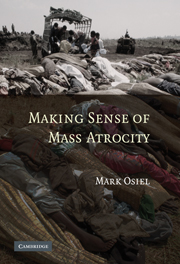Book contents
- Frontmatter
- Contents
- Dedication
- Preface
- Introduction
- 1 The Challenge of Prosecuting Mass Atrocity
- PART I LEGAL RULES AND THEIR PROBLEMS
- 2 The Responsibility of Superiors
- 3 Participating in a Criminal Enterprise
- 4 Defining the Criminal Enterprise
- 5 The Bureaucracy of Murder
- 6 Culpability, Character, and Context in Mass Atrocity
- PART II THE POLITICAL CONTEXT OF LEGAL CHOICE
- PART III NEW POSSIBILITIES AND SOLUTIONS
- Conclusion
- Index
- References
3 - Participating in a Criminal Enterprise
Published online by Cambridge University Press: 15 September 2009
- Frontmatter
- Contents
- Dedication
- Preface
- Introduction
- 1 The Challenge of Prosecuting Mass Atrocity
- PART I LEGAL RULES AND THEIR PROBLEMS
- 2 The Responsibility of Superiors
- 3 Participating in a Criminal Enterprise
- 4 Defining the Criminal Enterprise
- 5 The Bureaucracy of Murder
- 6 Culpability, Character, and Context in Mass Atrocity
- PART II THE POLITICAL CONTEXT OF LEGAL CHOICE
- PART III NEW POSSIBILITIES AND SOLUTIONS
- Conclusion
- Index
- References
Summary
The preceding chapter uncovered several major problems with employing the law of superior responsibility, in the aftermath of mass atrocity, to ascribe the acts of the lowest echelons to leaders like Milošević, Pinochet, and Saddam Hussein. As of 2008, only one ICTY defendant, Pavle Strugar, had been convicted solely on the basis of superior responsibility, and he was sentenced to only eight years' imprisonment.
Confronted with such obstacles, international prosecutors began to show great affinity for indicting defendants instead as “participants in a joint criminal enterprise.” This approach has been favored even when the accused clearly exercised a formal position of command. Of the indictments entered since judicial acceptance of this doctrine in 2001, nearly 65 percent rely on it. In fact, after 2004, the ICTY no longer proceeded at all with an analysis of superior responsibility once it found the defendant liable under at least one form of “commission,” such as enterprise participation.
This shift has been attributed to the simple fact that the term “joint criminal enterprise” sounds “more serious” than the alternatives and hence more seriously stigmatizes its perpetrators than does simply labeling them irresponsible superiors. It thereby advances the didactic aims of transitional justice, embraced by their democratic successors, it is said. But the political pressures of transitional justice cannot ultimately explain the shift in legal approach to linking big fish to small fry.
- Type
- Chapter
- Information
- Making Sense of Mass Atrocity , pp. 48 - 65Publisher: Cambridge University PressPrint publication year: 2009
References
- 1
- Cited by



